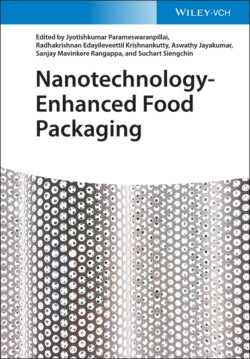Читать книгу Nanotechnology-Enhanced Food Packaging - Группа авторов - Страница 55
3.1.3 Starch Nanomaterials as Carriers of Bioactive Molecules
ОглавлениеOne of the most interesting applications of starch-based nanomaterials is in nanocarriers of bioactive molecules, as they are biodegradable, nontoxic, and biocompatible [54]. Most studies use SNPs as carriers, as they have shown an increase in both solubility and bioavailability of the bioactive molecules [54].
A study by Farrag et al. [55] presented results of the use of SNPs made from potato, pea, and corn starch to encapsulate quercetin. This molecule is a polyphenol found in many leaves, fruits, and vegetables, which is well-known for its antioxidant and anticancer activities, as well as for its low water solubility [56, 57]. It was reported that starch's amylopectin content has a significant effect on the molecule encapsulation. SNPs obtained from potato starch (highest amylopectin content) encapsulated higher quercetin molecules due to their higher amylopectin than SNPs obtained from corn starch; this as the branched regions produced by the amylopectin molecules allowed a better “accommodation” of the quercetin molecules [55]. Furthermore, they reported that quercetin antioxidant activity is preserved by encapsulation in the SNPs and is related to the SNPs loading capacity; thus, the higher loading percentage of quercetin leads to higher radical scavenging activity [55].
Another polyphenol that has nanoencapsulated in starch-based nanomaterials is curcumin, a molecule present in the rhizomes of turmeric, and it is well-known for its anticancer, antioxidant, anti-inflammatory, antimicrobial, and antiviral activity. Even curcumin has shown great potential in several biological applications, its use has been limited by its low water solubility and low bioavailability [58–66]. Chin et al. [67] used SNPs made from sago as carriers of curcumin, reporting particle sizes around 50–80 nm and loading capacity reaching around 78% [16].
In general, encapsulation of the bioactive molecules in SNP is mostly done using the anti-solvent synthesis method. In this method, an organic solvent containing the bioactive molecules is slowly added to gelatinized starch at room temperature. The molecules are then encapsulated in interior of the SNPs, due to its hydrophobic nature. In this method, it is possible to increase molecule encapsulation by reducing starch polarity through chemical modifications like acetylation or cross-linking with other molecules [10, 68]. This was considered by Pang et al. [69] in order to increase loading efficiency of curcumin into SNPs made from sago starch. They modified the SNPs by using maleate ester modified sago starch, reaching a loading capacity of 85%. Increasing loading capacity by chemical modification of the SNPs was also observed by Acevedo-Guevara et al. [10], using native and acetylated banana starch SNPs with higher encapsulation capacity and particle size in the modified SNPs than in their native counterpart. In both cases, it was explained that modifications such as acetylation and esterification lead to higher hydrogen bond interactions between the bioactive molecule and ester groups incorporated into the SNPs structure, leading to higher incorporation into the nanoparticle. Finally, Sadeghi et al. [17] studied the effect of the amylose/amylopectin ratios in different corn starch SNPs in curcumin encapsulation. It was reported that high amylose content leads to increasing SNPs sizes; furthermore, they observed that nanoencapsulation can be used to protect curcumin from photodegradation, as more than 83% of the encapsulated polyphenol remained after 10 days of storage.
Other molecules with high antioxidant activity has been encapsulated in SNPs. Report by de Oliveira et al. [70] showed that chemical such as acetylation increases loading capacities of both molecules. This was explained as the formation of specific interactions (hydrogen bonds) between the SNPs and the antioxidant molecules drives more molecules into the starch-based nanomaterial. Ahmad et al. [71] used SNPs made from horse chestnut, water chestnut, and lotus stem starch as carriers of catechin, while Shabana et al. [72] used SNCs obtained from potato starch to encapsulated antioxidant molecules (ascorbic and oxalic acid). Results showed that mechanical methods, such as ultrasound, lead to smaller particle sizes while increasing antioxidant loading capacity
Starch-based nanomaterials have also been used in order to protect vitamins, like vitamin A and vitamin D, due to their high lipophilic nature and easy degradation by light and oxygen [73–75]. Firstly, Hasanvand et al. [76] reported that SNPs made from high amylose maize can be used as carriers of vitamin D. They reported encapsulation values up to 78% and through the use of several techniques (DSC, FTIR, and XRD) observed the formation of hydrogen bonds between vitamin D molecules and the starch-based nanovehicle as the encapsulation main drive. More recently, Santoyo-Aleman et al. [68] used citric acid modified SNPs made from banana starch to encapsulate vitamin A. They reported that hydrogen bond formation between the citric acid molecules in the modified vehicle and the vitamin allowed higher encapsulation values.
Due to the high biocompatibility of starch and their edible nature, SNPs can be used as vehicles for controlled release of molecules in the gastrointestinal track. SNPs can be used to shield bioactive molecules from the harsh environment of the stomach (low pH and enzymatic attacks) while increasing release in the intestines [14, 32, 54]. Acevedo-Guevara et al. [10] showed that curcumin release from native and acetylated banana SNPs in simulated gastric and intestinal conditions occurred mostly in intestinal conditions, while the molecule was protected in the stomach simulation. Santoyo-Aleman et al. [68] used a native citric acid modified banana starch SNPs for β-carotene release and encapsulation, reporting that the resistant nature of banana starch to acid hydrolysis led to an increasing stability of the carotene molecule in the gastric conditions. Finally, Ahmad et al. [71] reported that SNPs extracted from horse chestnut, water chestnut, and lotus can be used for the controlled release of catechin in gastric conditions. As explained starch-based nanoencapsulation is an efficient tool in the preservation of catechin bioactive properties in the harsh conditions of the stomach.
